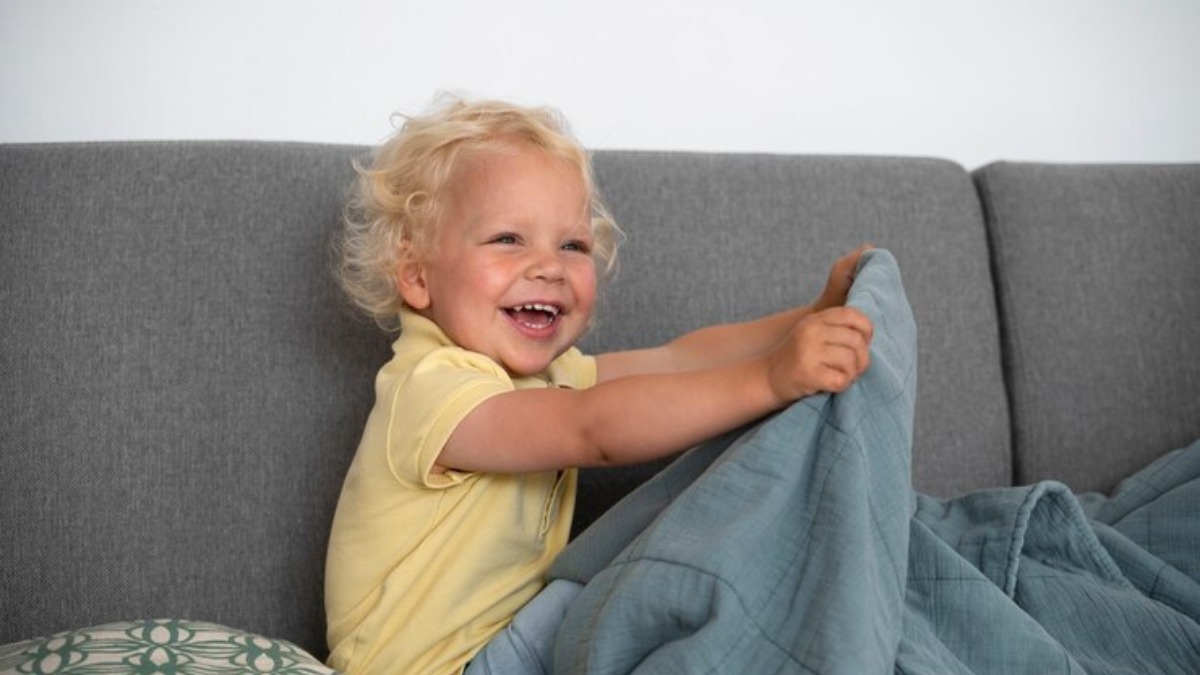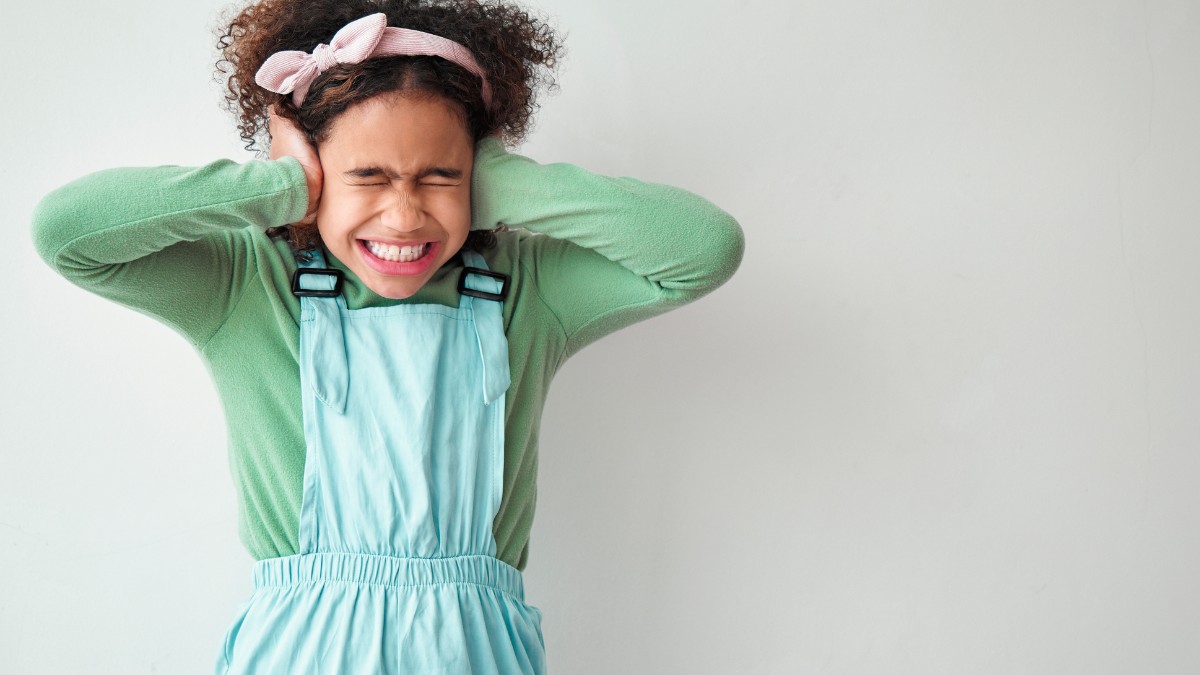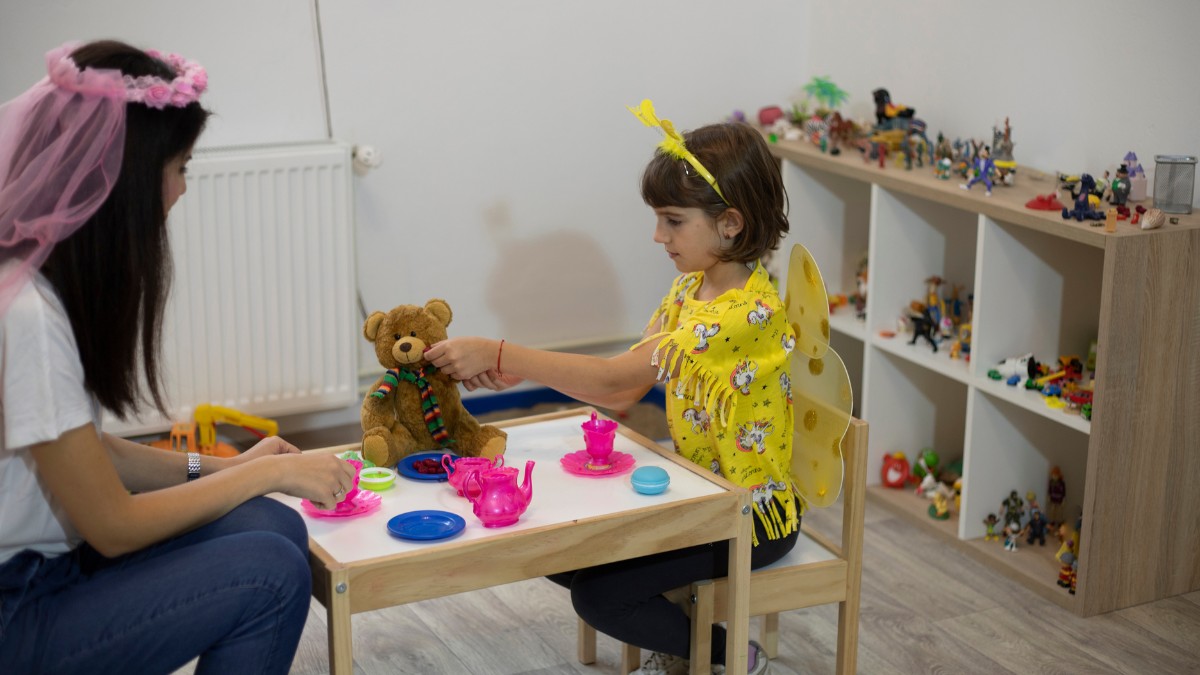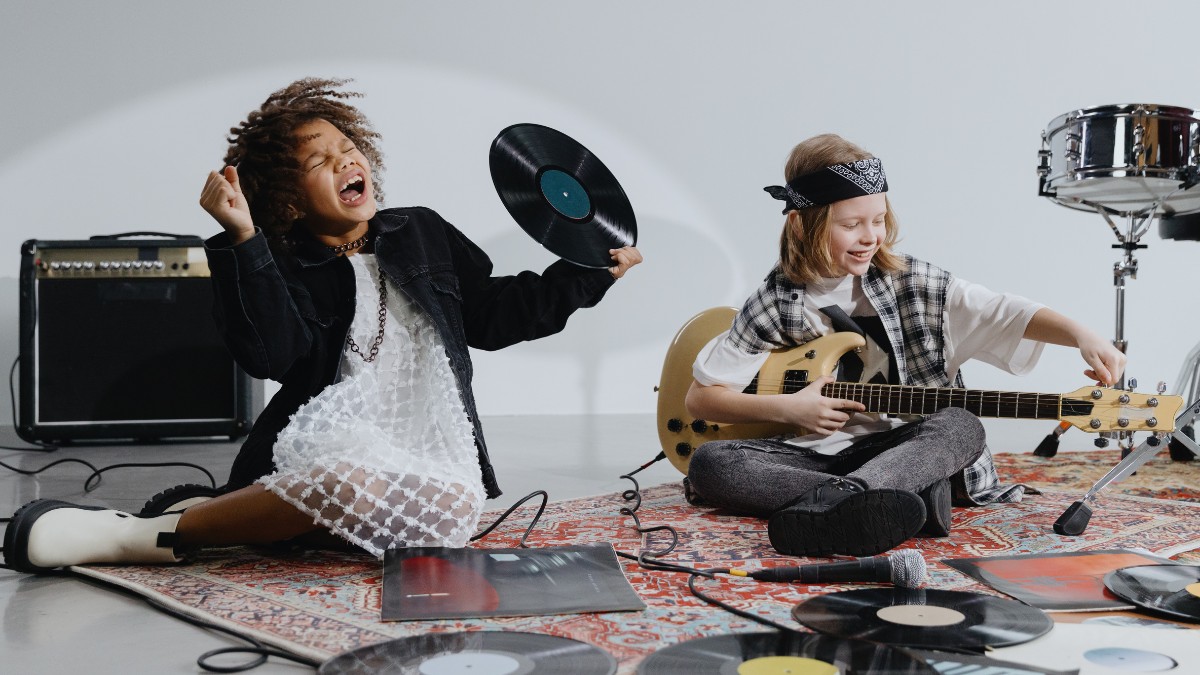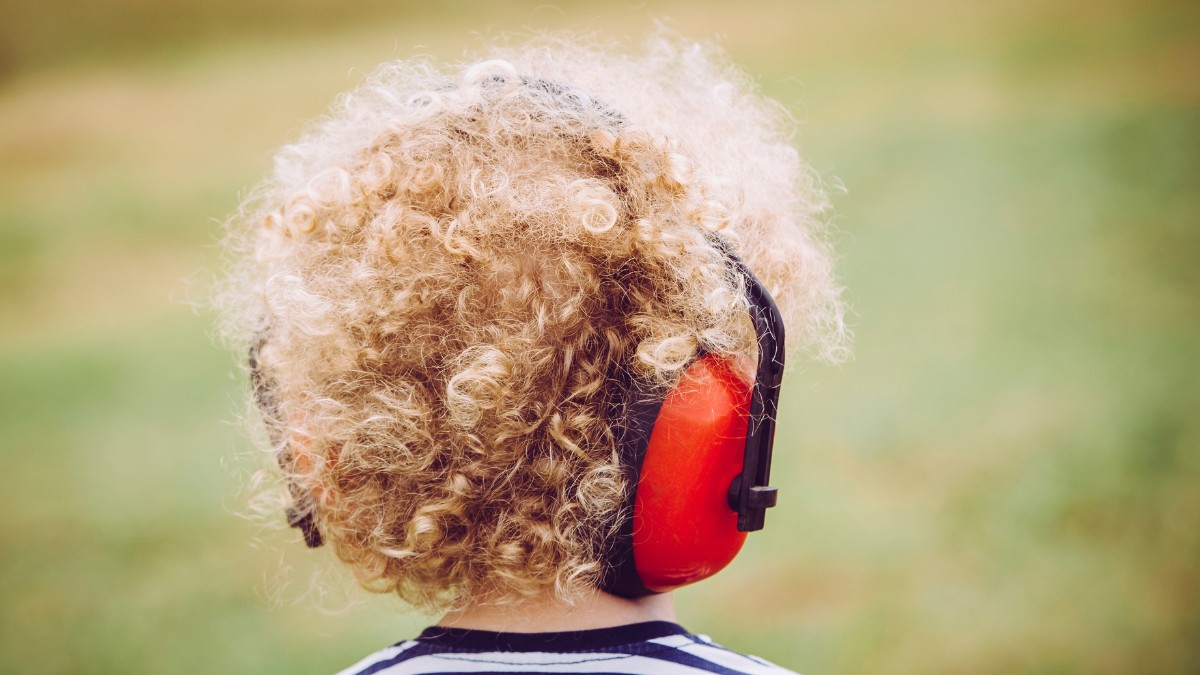Key Points:
- Weighted blankets for autism can improve sleep, reduce anxiety, and promote sensory regulation.
- Deep pressure stimulation from weighted blankets helps calm the nervous system and support focus.
- Choosing the right blanket involves weight, size, safety, and individual sensory preferences.
For many children on the autism spectrum, sleep difficulties, anxiety, and sensory dysregulation can significantly affect daily life. In fact, research shows that up to 80% of autistic children experience sleep disturbances, often stemming from challenges with sensory processing and anxiety. Finding safe, non-invasive ways to help them feel calm, secure, and well-regulated is essential for their well-being.
Weighted blankets have become a popular therapeutic tool for addressing these needs. By providing gentle, consistent pressure across the body, known as deep pressure stimulation, these blankets can help soothe the nervous system, ease anxiety, and improve sleep quality.
In this article, we’ll go over the science behind weighted blankets, their benefits for children with autism, how to choose the right one, and how they can complement ABA therapy and daily routines.

Benefits of Weighted Blankets for Autism
Weighted blankets can support children with autism by improving sleep, reducing anxiety, and providing calming sensory input. These effects stem from deep pressure therapy, which helps regulate the nervous system.
The added weight mimics a gentle, firm hug, providing consistent tactile feedback that soothes the body. For many autistic individuals, especially those with sensory processing differences, this form of input can be grounding and reassuring. Let’s explore how and why weighted blankets may work.
How Do Weighted Blankets Work for Children with Autism?
Weighted blankets work by using a method known as deep pressure stimulation (DPS). This involves applying gentle, evenly distributed weight across the body, triggering the parasympathetic nervous system, responsible for the “rest and digest” response. As a result, the body releases neurotransmitters like serotonin and dopamine, which contribute to feelings of calm and relaxation.
Children on the autism spectrum often face challenges regulating sensory input. For some, even minor stimuli can be overwhelming. Weighted blankets serve as a predictable and soothing counterbalance to sensory overload, helping reduce meltdowns and promote emotional stability.
What are the Sensory Benefits of Weighted Blankets?
Sensory regulation is a common goal for autistic children, especially those with heightened sensitivity to touch, sound, or movement. Weighted blankets can help support sensory processing through consistent tactile input. These sensory benefits are especially helpful during transition times, bedtime routines, or stressful situations when regulation is most needed.
Examples of sensory improvements include:
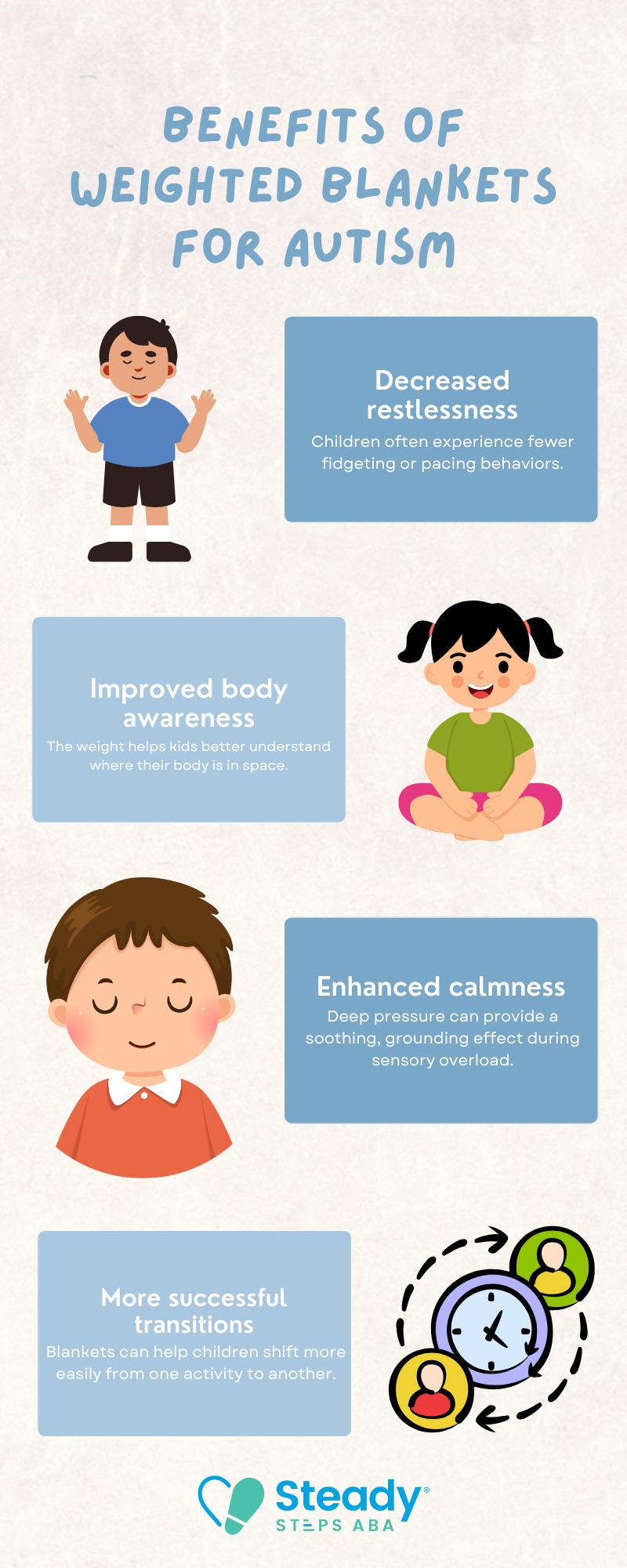
Can Weighted Blankets Help Improve Sleep in Autistic Children?
Yes, weighted blankets can help improve sleep in autistic children by using deep pressure stimulation (DPS) to calm the nervous system. This gentle, evenly distributed weight mimics a firm hug, encouraging the release of calming neurotransmitters like serotonin and dopamine. As a result, many children experience reduced anxiety at bedtime, fall asleep faster, and wake up less frequently during the night.
Weighted blankets offer a non-invasive, sensory-friendly solution that fits easily into existing nighttime routines. Parents often observe more consistent sleep patterns, fewer bedtime struggles, and improved mood throughout the day when a weighted blanket is part of the sleep routine.
Do Weighted Blankets Help with Anxiety in Autism?
Anxiety is a common co-occurring condition for children with autism, often triggered by changes in routine, sensory overwhelm, or social challenges. Weighted blankets can serve as a non-verbal, non-intrusive way to help soothe anxious feelings.
This is especially helpful for nonverbal or minimally verbal children who may have difficulty expressing their distress. The even pressure of a weighted blanket sends signals to the brain that the body is safe and grounded. Since many autistic individuals also exhibit subtle, involuntary behaviors as signs of discomfort or sensory overload—such as unusual eye movements—it’s worth exploring more in-depth insights from our article Strange Eye Movements in Autism: Causes, Symptoms, and Treatments.
What Should Parents Look for in a Weighted Blanket?
Not all weighted blankets are created equal. Choosing the right one involves understanding your child’s specific sensory needs and safety considerations. A good rule of thumb is to select a blanket that is roughly 10% of the child’s body weight, plus or minus a pound.
Parents should also consider the child’s ability to remove the blanket independently, especially if it’s used during unsupervised times like nighttime sleep. Fabric, filler material, and size all influence comfort and usability.
Factors to consider when choosing a weighted blanket include:
1. Weight Appropriateness
Choose a blanket that is around 10% of your child’s body weight to ensure effective deep pressure without compromising comfort or safety.
2. Breathable Material
Opt for breathable fabrics like cotton or bamboo to keep your child cool and comfortable, especially during sleep or warm seasons.
3. Even Weight Distribution
Select a blanket with evenly distributed weight—typically sewn into quilted pockets—to provide consistent pressure across the entire body and avoid bunching.
4. Machine Washable
Pick a blanket that’s easy to wash and maintain, as frequent use means it will need regular cleaning for hygiene and convenience.
5. Child-Safe Design
Ensure the blanket has no loose parts or choking hazards and that your child can remove it independently to promote safe, worry-free use.
When and How Should Weighted Blankets Be Used?
Weighted blankets should be introduced gradually and used during calm, supervised times at first. Observe how your child responds, and adjust usage based on their comfort and preferences. They can be helpful tools for relaxation during:
- Bedtime or naptime.
- Quiet time after overstimulation.
- Long car rides or plane travel.
- After-school wind-down routines.
- ABA therapy sessions or OT breaks.
It’s important not to use weighted blankets as a restraint or to manage behavior. Instead, they should be offered as a supportive option your child can choose when they need comfort or regulation.
Are There Any Risks or Precautions to Using Weighted Blankets?
While weighted blankets are generally safe when used correctly, they are not suitable for every child. Children under 2 years of age, or those with respiratory, circulation, or seizure disorders, should not use them without medical consultation.
Always monitor your child, especially during early use. Ensure they can remove the blanket themselves and that it does not cover the face or restrict movement.
Safety guidelines to follow include:
1. Supervise Use Initially
Closely monitor your child during early use of the blanket to ensure they respond positively and that it supports regulation safely.
2. Check for Discomfort
Watch for signs of overheating, restlessness, or distress, which may indicate the blanket is too heavy or uncomfortable for your child.
3. Avoid Overnight Use for Younger Kids
Start with short, supervised sessions like naps or rest times rather than overnight use for toddlers or young children under age 2.
4. Avoid Use if Child Resists
Never force a child to use a weighted blanket. Sensory input should be voluntary, calming, and based on individual comfort and preference.
5. Consult a Provider if Unsure
Speak with your child’s occupational therapist or ABA provider to ensure the blanket is appropriate and aligns with your child’s sensory needs.
How Do Weighted Blankets Fit into ABA Therapy?
Weighted blankets can be a valuable sensory support tool in ABA therapy programs. While they are not a core intervention, they may help prepare children for learning activities by regulating sensory input and improving focus.
In behavior-based settings, therapists might incorporate weighted blankets as part of a sensory diet, during calm-down routines, or as a reinforcement strategy for completing tasks. The key is individualization—what works for one child may not work for another. For more tailored strategies that support sensory regulation, check out our article Sensory Breaks for Autism: Ideas and Activities.
Blankets can also help children build independence by recognizing their own sensory needs and advocating for regulation tools when needed.
Create Meaningful Change With ABA Therapy
At Steady Steps ABA, we understand how important it is to support your child’s sensory processing and emotional regulation needs. Weighted blankets, when used safely and appropriately, can be a valuable complement to ABA goals such as increasing independence, focus, and self-soothing strategies.
Our team delivers personalized ABA therapy in Maryland, helping children with autism develop life skills through evidence-based practices and compassionate care. We work closely with families to ensure every tool and strategy—including sensory supports—are tailored to each child’s strengths and needs.
Contact us today to learn how our ABA therapy in Maryland can support your child’s growth, sensory needs, and daily routines. Let’s take the next step together.

